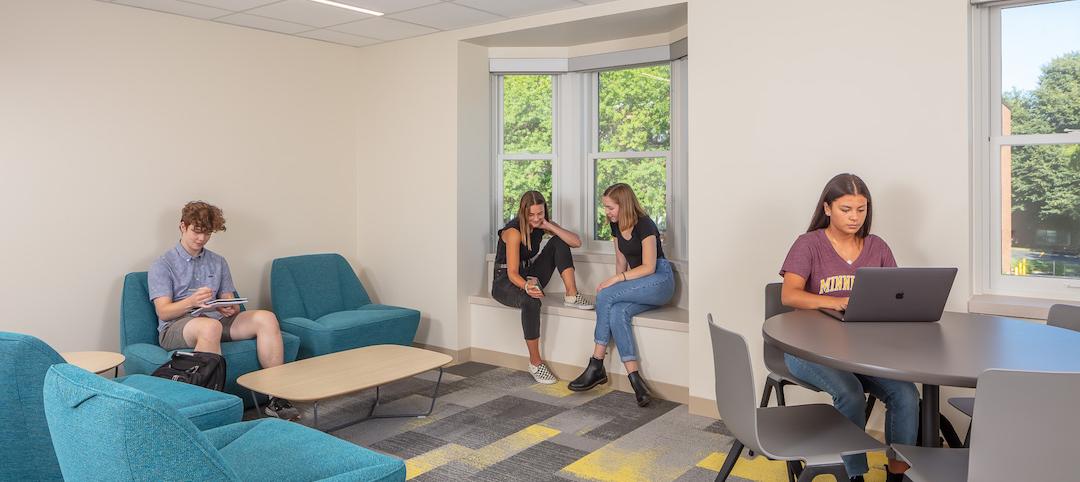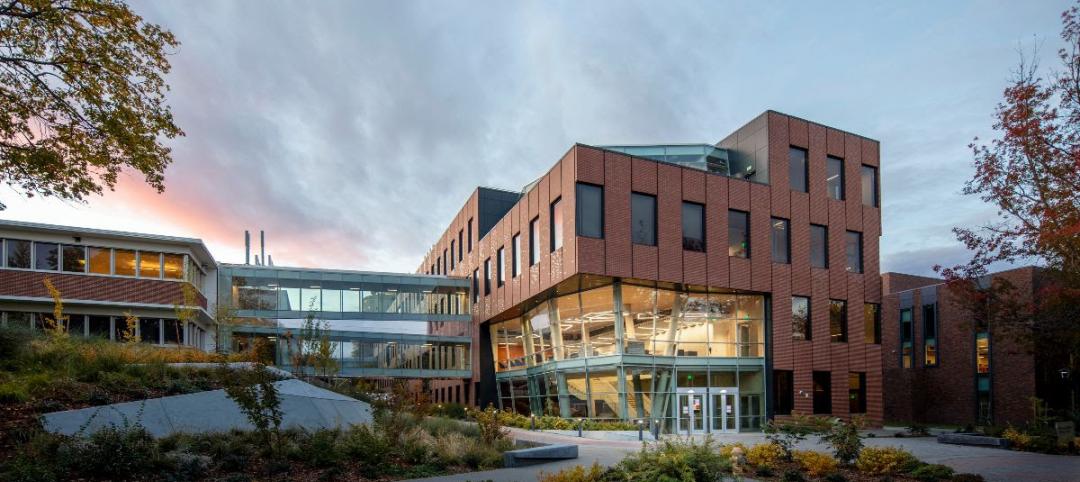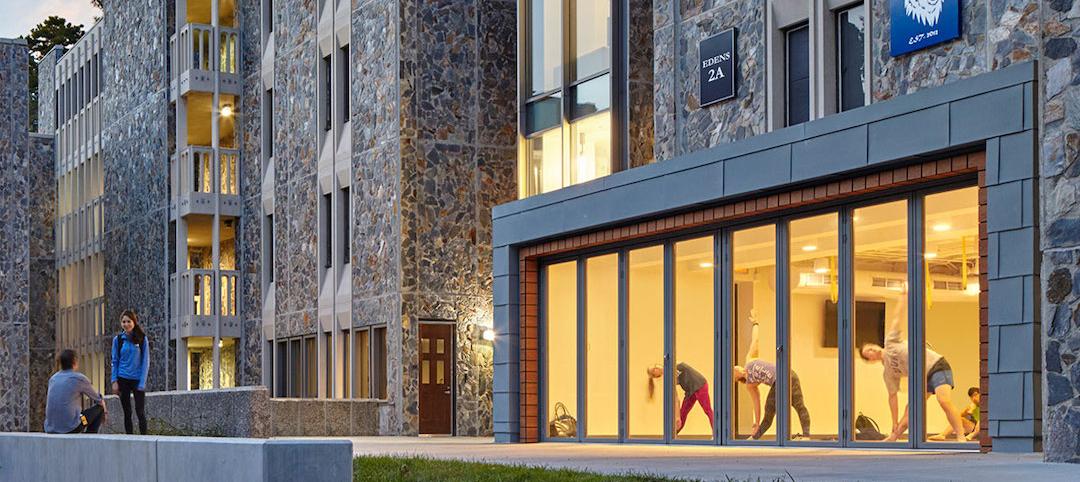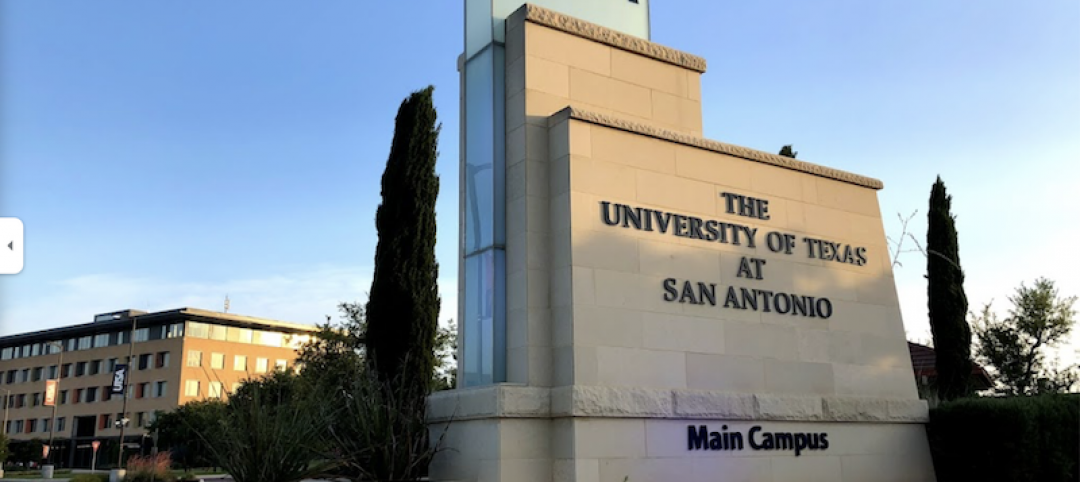
The city of Phoenix has sprawling suburbs, but its outward expansion caused the downtown core to stagnate—a problem not uncommon to other major metropolitan areas. Reviving the city became a hotbed issue for Mayor Phil Gordon, who envisioned a vibrant downtown that offered opportunities for living, working, learning, and playing.
The Mayor's plans for downtown redevelopment involved public-private partnerships, which led him to Arizona State University President Michael Crow. Crow was interested in expanding ASU's presence within the metro Phoenix area (ASU's main campus is in Tempe), so the city and school jointly developed a master plan for a new campus on nine city blocks. In 2006, voters approved $223 million in bonds, with $71 million slated for construction of the Walter Cronkite School of Journalism and Mass Communication, the new campus's first facility.
 |
| The two-story First Amendment Forum serves as the school’s “living room,” with a mezzanine level offering extra seating. Large windows between the forum and adjoining spaces, such as conference rooms and the Library & Student Resource Center, create a feeling that activities are always “on air.” |
The RFP for a design-build team was won by the alliance of HDR Architecture (executive architect), Ehrlich Architects (design architect), and Sundt Construction (GC) and required the team to adhere to an absolute fixed budget and a maximum 20-month timeline from award to occupancy certificate.
The Building Team utilized integrated project delivery and BIM to stay on time and on budget. Among other things, IPD and BIM enabled the Building Team to create detailed cost models instead of cost estimates, so that by the close of business every Friday the project budget was rectified.
IPD also helped with the fast-track schedule by allowing the project to be broken up into multiple packages, each with its own senior IPD leader and production team. The strategy allowed foundations to be poured before the superstructure design was complete and before the exterior skin was finalized. A special team was assigned to acquiring entitlements and building permits to accommodate the project's breakneck pace, and the city helped expedite the review process.
 |
| Studio spaces were built out quickly, but during interior improvements the floors received a top coating to create a camera-friendly flatness. |
The building's basic rectilinear form—a simple 30-foot-square exposed structural concrete column grid, burnished concrete block walls, and insulated cladding—was a practical choice for the project's budget and timeline. It enabled the Building Team to maximize square footage: ASU had a lengthy list of features they needed to squeeze into the six-story, 223,000-sf facility. The Walter Cronkite School of Journalism and Mass Communication is sandwiched between the building's ground floor, which houses the main lobby and retail and restaurant space, and the top floor, which is utilized by the city's PBS station, KAET/Channel 8. The university space includes 12 classrooms, seven working newsrooms, two state-of-the-art television studios, a library, a 150-seat theater-style auditorium, and a 1,500-sf exhibition gallery.
The centerpiece is a large “living room,” dubbed the First Amendment Forum. This two-story space—with mezzanine—is used as a gathering area for students during the day, while in the evening it becomes a public forum for students and industry leaders to engage in discussion and debate. Five hi-def flat-screen televisions and a large hi-def rear projector broadcast the day's news and other events. Walter Cronkite's famous sign-off, “And that's the way it is,” is inscribed on one wall.
To moderate the monolithic effect of the rectangular building, the Building Team sliced off a bit here and there and bumped out stairwells several feet from exterior walls. A combination of thin vertical and long horizontal windows, a wraparound exterior balcony, and multicolored corrugated metal cladding in a pattern inspired by FCC's radio spectrum chart further break up what could be a blocky exterior.
The facility opened in May 2008, and is adjacent to a pedestrian boulevard and across the street from a newly completed high-rise residence hall and a student union created by the adaptive reuse of a historic post office building. The city's new light rail system stops near the main entrance. The downtown now bustles with student life.
The project impressed Building Team Awards judge Dan Huntington. “Twenty months from start to certificate of occupancy on a building this size—that's pretty impressive,” says Huntington, SE, PE, LEED AP, associate principal at KJWW Engineering Consultants in Rock Island, Ill. “They had a very large task put in front of them, and they were very successful.”
Related Stories
Education Facilities | Jan 5, 2022
Student housing for Gen Z students will emphasize digital technology and ‘alone together’ spaces
As digitally engaged as Generation Z is, they still value and desire in-person communication and socialization.
2021 Building Team Awards | Nov 17, 2021
Caltech's new neuroscience building unites scientists, engineers to master the human brain
The Tianqiao and Chrissy Chen Institute for Neuroscience at the California Institute of Technology in Pasadena wins a Gold Award in BD+C's 2021 Building Team Awards.
Designers / Specifiers / Landscape Architects | Nov 16, 2021
‘Desire paths’ and college campus design
If a campus is not as efficient as it could be, end users will use their feet to let designers know about it.
Higher Education | Oct 26, 2021
The Interdisciplinary Science Center at Eastern Washington University completes
LMN Architects designed the building.
Cladding and Facade Systems | Oct 26, 2021
14 projects recognized by DOE for high-performance building envelope design
The inaugural class of DOE’s Better Buildings Building Envelope Campaign includes a medical office building that uses hybrid vacuum-insulated glass and a net-zero concrete-and-timber community center.
Higher Education | Sep 30, 2021
How design can support student wellness on higher ed campuses
Over the last year, the pandemic has spotlighted the importance of promoting student well-being through a holistic system of environments and resources.
Laboratories | Aug 31, 2021
Pandemic puts science and technology facilities at center stage
Expanding demand for labs and life science space is spurring new construction and improvements in existing buildings.
Giants 400 | Aug 30, 2021
2021 Giants 400 Report: Ranking the largest architecture, engineering, and construction firms in the U.S.
The 2021 Giants 400 Report includes more than 130 rankings across 25 building sectors and specialty categories.
Higher Education | Aug 30, 2021
The University of Texas at San Antonio combines its colleges of engineering and architecture
LPA Architects’ local office pushed for this to better prepare students to meet climate change challenges.
Giants 400 | Aug 26, 2021
2021 University Giants: Top architecture, engineering, and construction firms in the higher education sector
Gensler, AECOM, Turner Construction, and CannonDesign head BD+C's rankings of the nation's largest university sector architecture, engineering, and construction firms, as reported in the 2021 Giants 400 Report.
















